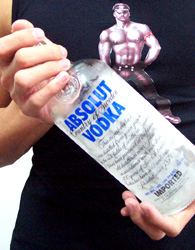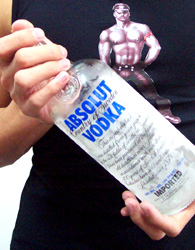Long before Stonewall and the modern gay revolution, gay men and women congregated in bars seeking sexual partners, social camaraderie, relative safety and respite from the anti-gay norms of the time. Given the ubiquity of alcohol in most Western cultures, it isn't at all surprising that bars and clubs continue to be important landmarks on the gay and lesbian social landscape. Indeed, for many just coming out, bars are frequently the first and most lasting social venue for meeting other members of the community.

Alcohol is a depressant and anaesthetic. When you take a drink, the alcohol is rapidly absorbed through your stomach and intestines and slows nerve impulses in your brain. As alcohol blood levels rise, you may feel giddy, uninhibited and more sociable, while you rapidly loose the ability to perform complex brain functions. Your speech becomes slurred, you have difficulty maintaining your balance and your judgement is impaired.
Your body needs water to break down alcohol and will draw it from other stores in your body if it has to. Your splitting headache the morning after results from your dehydration.
How is it used?
In 1996, the National Institute of Alcohol Abuse and Alcoholism estimated Americans consume an average of 2.21 gallons of ethyl alcohol per person per year: the equivalent of about 50 gallons of beer, 20 gallons of wine, or five gallons of liquor for every person in the country. If the prevalence of drinking is even marginally higher in the gay community, and most social welfare and health professionals believe it is, there's a hell of a lot of drinking going on.
There are, of course, varying degrees of alcohol use and abuse. But you must first realize alcohol dependency can creep up slowly on people. Alcohol is a drug, and like any drug, regular consumption can and often does lead to dependency and addiction.
Physiological Impact
Where to begin? First off, alcohol on its own promotes a wide range of psychological and physiological responses. Alcoholism is just one behavioural extreme and can cause a host of resulting medical conditions including liver damage and cirrhosis. Even recreational or binge drinking can have serious health consequences.
According to the National Highway Traffic Safety Administration, alcohol was a contributing factor in nearly 16,000 traffic fatalities in the United States last year, and is conservatively estimated to play some role in approximately 100,000 deaths annually.
Strong associations between alcohol use and high-risk sexual behaviour among gay men has been reported by the government since at least the early 1990s.

A 1998 NIH report says that alcohol abuse carries a wide range of social, legal and occupational hazards: problems with friends, loved ones, partners and family; problems at work; problems with the law; financial difficulties; greater risk of accidental injury, death and a long list of other health problems.
Liver and heart disease are commonly associated with alcohol abuse. Even moderate alcohol consumption -- over the long term -- can result in hypertension (high blood pressure) or an irregular heart rate and heart disease. Liver damage is also a risk to even heavy social drinkers.
Liver damage includes a fatty build-up with liver enlargement, abdominal discomfort and sometimes temporary jaundice and liver malfunction. Alcoholic Hepatitis is another dangerous complication and is characterized by nausea, vomiting, abdominal pain, fever, jaundice, enlarged and tender liver, and an elevation of your white blood cell count. Sometimes alcoholic hepatitis may be present without symptoms. It can progress to cirrhosis if you continue to drink. Cirrhosis occurs in 10 percent to 15 percent of people who consume large amounts of alcohol over a long period of time.
Dangerous complication/interactions
For people on prescription medications, alcohol can hinder the body's ability to process or metabolise the medication. This can either keep the medication in the system longer than intended or negate its effects entirely.
Alcohol is a depressant and when combined with anti-depressants it can increase its sedative effects and produce dangerously high blood pressure in some people.
When combined with frequently abused sedative hypnotics such as Ketamine or GHB, alcohol can greatly increase the depressant effects of these drugs and knock the user unconscious or quickly into a coma, respiratory or cardiac arrest. Many have never recovered.
Recent research has revealed a potentially dangerous interaction between cocaine and alcohol.
When combined, the two drugs are converted into cocaethylene in the body, which lasts longer and is more toxic than either cocaine or alcohol alone. Cocaine and alcohol is the most common two-drug combination causing drug-related deaths in the United States.











 打印版本
打印版本











读者回应
抢先发表第一个回应吧!
请先登入再使用此功能。